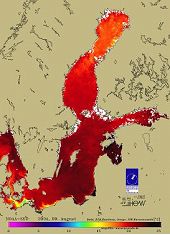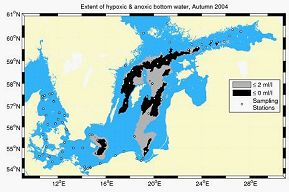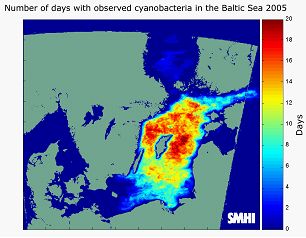HELCOM Indicator Fact Sheets for 2005
As the environmental focal point of the Baltic Sea, HELCOM has been assessing the sources and inputs of nutrients and hazardous substances and their effects on ecosystems in the Baltic Sea for almost 30 years. The resulting indicators are based on scientific research carried out around the Baltic Sea under the HELCOM PLC and COMBINE monitoring programmes. During the past few years, HELCOM Indicator Fact Sheets have been compiled by responsible institutions and approved by the HELCOM Monitoring and Assessment Group. The Indicator Fact Sheets for 2005 are listed in the navigation menu on the left and older ones can be found in the Indicator Fact Sheet archive.
Changing seasons
The development of sea surface temperature in the Baltic Sea in 2004 was characterised by rather cold months of June and July and by a warm August. The wave climate in the northern Baltic Sea in 2004 was charactrised by a spring season that was calmer than usual and by a storm in December during which the significant wave heigth in the northern Baltic Proper reached a record value of 7.7 meters. The following ice winter was, by the extent of the ice cover, classified as normal. The break up of ice was in most waters earlier than normal and on the 23rd of May the Baltic Sea was ice free.
Life pulsates according to water inflows
The present state of the Baltic Sea is not only the result of the anthropogenic pressures but is also influenced hydrographic forces, such as water exchange between the Baltic Sea and the North Sea. After the major Baltic inflow in January 2003, which renewed most of the deep water in the Baltic Sea, no new major inflow has taken place and the near-bottom water in the Bornholm and eastern Gotland Basin returned back to anoxic conditions in the middle of 2004.
The Baltic Sea continues to suffer the impacts of human activities
Baltic Sea habitats and species are threathened by eutrophication and elevated amounts of hazardous substances as a result of decades of human activities in the surrounding catchment area and in the sea.
Eutrophication is the result of excessive nutrient inputs resulting from a range of anthropogenic activities. Nutrients enter the either via runoff and riverine input or through direct discharges into the sea. Although nutrient inputs from point sources such as industries and municipalities have been cut significantly, the total input of nitrogen to the Baltic Sea is still over 1 million tonnes per year, of which 25 % enters as atmospheric deposition on the Baltic Sea and 75 % as waterborne inputs. The total input of phosphorus to the Baltic Sea is ca. 35 thousand tonnes and enters the Baltic Sea mainly as waterborne input with the contribution of atmospheric deposition being only 1-5 % of the total. The main source of nutrient inputs is agriculture. (Please note that Indicator Fact Sheets on nutrient inputs to the Baltic Sea will be published in the near future).
The inputs of some hazardous substances to the Baltic Sea have been reduced considerably over the past 20 to 30 years. In particular discharges of heavy metals have decreased. The large majority of heavy metal enters the Baltic Sea via rivers or as direct discharges: 50 % for mercury, 60-70 % for lead and 75-85 % for cadmium. The remaining share of inputs is mainly from atmospheric deposition of these heavy metals.
Eutrophication intensifies phytoplankton blooms
The waterborne loads for nitrogen and phosphorus were significantly higher in 2004 compared to the previous year, partly due to the natural flutuations in inputs caused by varying hydrographical conditions. Annual emissions of nitrogen from the HELCOM Contracting Parties were lower in 2003 than in 1995. Mainly because of interannual changes in meteorology, no significant temporal pattern in nitrogen depositions to the Baltic Sea and its sub-basins can be detected, however depositon in 2003 was 11% lower than in 1995.
Eutrophication is an issue of major concern almost everywhere around the Baltic Sea area. The satellite-derived chlorophyll-like pigments in the Baltic Sea are clearly higher than in the Skagerrak and North Sea. The average biomass production has increased by a factor of 2.5 leading to decreased water clarity, exceptionally intense algal blooms, more extensive areas of oxygen-depleted sea beds as well as degraded habitats and changes in species abundance and distribution.
Annual integrated rates for sedimentation of organic matter in the Gotland Sea have not show significant trends between 1995 and 2003. However, decrease in water clarity has been observed in all Baltic Sea sub-regions over the last one hundred years, with it being most pronounced in the Northern Baltic Proper and the Gulf of Finland.
Although no rising trend can be detected in spring blooms from 1992 to 2005, the 2005 spring bloom in the Gulf of Finland was more intense than in the previous year while negligable in the Arkona Basin.
Due to the poor weather during the summer of 2004, there were no major cyanobacteria blooms that year. As a result, levels of dissolved inorganic nutrients in the winter nutrient pool remained extremely high throughout the Baltic Proper and meant that the risk for severe cyanobacterial blooms remained. The average concentrations of dissolved inorganic nitrogen were lower in all regions except at the entrance to and within the Gulf of Finland throughout the year 2004 when compared to the reference (the average of the years 1993-2003). This was confirmed by the 2005 summer blooms of cyanobacteria being amongst the most intense and widespread ever encountered in the Northern and Central Baltic Proper. High surface water temperatures are a prerequisite for intensive blooms of toxic Nodularia species.
In 2004, the abundance of the nitrogen fixing cyanobacteria as well as the ratio between the toxic Nodularia spumigena and the non-toxic Aphanizomenon flos-aquae were almost at the same level as in the previous four years.
Heavy metals and organic pollutant still persistent in marine environment
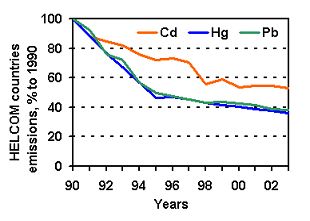 The inputs of some hazardous substances to the Baltic Sea have reduced considerably over the past 20 to 30 years. However, the concentrations of heavy metals and organic pollutants in sea water are still several times higher in the Baltic Sea compared to waters of the North Atlantic. As a result of efforts to reduce pollution, annual emissions of heavy metals to the air have decreased since 1990 and consequently their annual deposition onto the Baltic Sea has also halved since 1990. Riverine heavy metal loads (notably cadmium and lead) have also decreased for most of coastal states.
The inputs of some hazardous substances to the Baltic Sea have reduced considerably over the past 20 to 30 years. However, the concentrations of heavy metals and organic pollutants in sea water are still several times higher in the Baltic Sea compared to waters of the North Atlantic. As a result of efforts to reduce pollution, annual emissions of heavy metals to the air have decreased since 1990 and consequently their annual deposition onto the Baltic Sea has also halved since 1990. Riverine heavy metal loads (notably cadmium and lead) have also decreased for most of coastal states.
Concentrations of contaminants in fish vary according to substance, species and location, but in general, the concentrations of cadmium, lead and PCBs have decreased. Still the content of dioxins in the fish muscle may exceed the authorized limits set by the European Commission.
Overall the levels of radioactivity in the Baltic Sea water and biota have shown declining trends since the Chernobyl accident in 1986, which caused significant fallout over the area. Radioactivity is now slowly transported from the Baltic Sea to the North Sea via Kattegat. The amount of caesium-137 in Baltic Sea sediments however has remained largely unchanged, with highest concentrations in the Bothnian Sea and the Gulf of Finland.
Habitats and species under threat
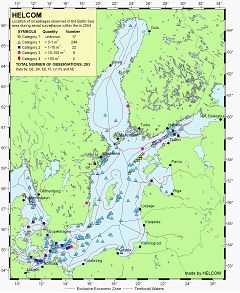 This year HELCOM introduces its first biodiversity indicators. The degenerating state of the the Baltic Sea affects marine life in many ways. Macrobenthic communities have been severely degraded by increased eutrophication throughout the Baltic Proper and the Gulf of Finland and are below the longterm averages. Populations of the amphipod Monoporeia affinis have crashed in the Gulf of Bothnia and the invasive polychaete Marenzelleria viridis has spread.
This year HELCOM introduces its first biodiversity indicators. The degenerating state of the the Baltic Sea affects marine life in many ways. Macrobenthic communities have been severely degraded by increased eutrophication throughout the Baltic Proper and the Gulf of Finland and are below the longterm averages. Populations of the amphipod Monoporeia affinis have crashed in the Gulf of Bothnia and the invasive polychaete Marenzelleria viridis has spread.
The lack of salt water inflows has diminished the habitat layer for heterotrophic organisms in general and those of marine origin, such as copepods, in particular. Although the total number of copepods has not change dramatically, the ratio between different species has been affected which in turn has had consequences in higher trophic levels. Herring for instance has suffered from a decline in its favoured diet and now competes with sprat for other species of copepods.
Decrease in observed illegal oil spills
An increase in the number of maritime transportation during the past decade has increased the potential for an increased numbers of illegal oil discharges. Since the late 1990s ships have been required to deliver oil or oily water from the machinery spaces as well as from ballast or cargo tanks to reception facilities in ports. As of 1999, the number of observed illegal oil discharges has gradually been decreasing every year, but in 2004, still almost 300 illegal spills were detected.
Information on the long-term varaitions in the Baltic marine environment can be found in:
The Baltic Marine Environment 1999-2002 (2003)
Radioactivity in the Baltic Sea 1992-1998 (2003)
Fourth Periodic Assessment of the State of the Marine Environment of the Baltic Sea Area, 1994-1998 (2003)
Fourth Periodic Assessment of the State of the Marine Environment of the Baltic Sea, 1994-1998; Executive Summary (2001)
List of 2005 Indicator Fact Sheets
Total and regional Runoff to the Baltic Sea
Water exchange between the Baltic Sea and the North Sea and conditions in the deep basins
Hydrography and Oxygen in the Deep Basins
Wave climate in the northern Baltic Sea in 2004
Sedimentation of particulate organic matter in the central Baltic basin
Water transparency in the Baltic Sea between 1903 and 2005
Development of Sea Surface Temperature in the Baltic Sea in 2004
Spatial distribution of the winter nutrient pool
Temporal and spatial variation of dissolved nutrients in the Baltic Sea in 2004
Waterborne inputs of nitrogen and phosphorus in 2004
Nitrogen emissions to the air in2003
Atmospheric nitrogen depositions to the Baltic Sea in 2003
Cyanobacterial blooms in the Baltic Sea
Waterborne inputs of heavy metals in 2004
Atmospheric depositions of heavy metals on the Baltic Sea
Habitat layer extension and the occurrence of dominant calanoid copepods in the Baltic Sea
Lead concentrations in fish liver
PCB concentrations in fish muscle
Cadmium concentrations in fish liver
Total amounts of the artificial radionuclide caesium -137 in Baltic Sea sediments
Concentrations of the artificial radionuclide caesium-137 in Baltic Sea fish and surface waters


